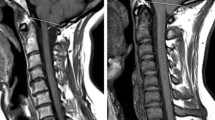Abstract
Cerebellar ectopia, once considered rare, is apparently extremely common on magnetic resonance imaging (MRI). However, assessment of cerebellar position relative to the foramen magnum is usually made from thick sagittal sections and therefore may not be as reliable as sometimes believed. Volumetric MRI, acquired in the coronal plane with section thickness 1.5 mm, was used to assess the position of the cerebel-lum in 144 subjects who also had two-dimensional sagittal imaging using 5.0 mm thick sections. On these images, the frequency of cerebellar ectopia appeared to be 19% (27 cases), but volumetric coronal images indicated that the biventral lobules protruded below the foramen magnum in only 3 (2%), and the cerebellar tonsils lay well above in all cases. Hence the actual frequency of cerebellar tonsillar ectopia in this sample was zero. We concluded that cerebellar ectopia really is rare.
Similar content being viewed by others
References
Chiari H (1891) Über Veränderungen des Kleinhirns infolge von Hydrocephalie des Grosshirns. Dtsch Med Wochenschr 17: 1172–1175
Baker H (1963) Myelographic examination of the posterior fossa with positive contrast medium. Radiology 81:791–801
Woosley RE, Whaley RA (1982) Use of metrizamide in computerized tomography to diagnose the Chiari 1 malformation. J Neurosurg 56:373–376
DiLorenzo N, Bozzao L, Antonelli M, Fortuna A (1981) Arnold-Chiari malformation detected by unenhanced multiplanar CT scan. Surg Neur 16:340–345
Miyasaka K, Isu T, Abe S, et al (1982) Computed tomography of developmental anomalies of the cranio-cervical junction. Neurol Surg 10:1165–1172
Hochman MS, Kobetz SA, Sneider SE, Zumpano BJ (1981) Adult Arnold Chiari malformation type 1 demonstrated by CT metrizamide myelography. Surg Neurol 16:467–468
Atlas SW (ed) (1991) Magnetic resonance imaging of the brain and spine. Raven Press, New York, pp 165–170
Hawkes RC, Holland GN, Moore WS, Corston R, Kean DM, Worthington BS (1983) Cranio-vertebral junction pathology: assessment by NMR. AJNR 4:232–233
De La Paz RL, Brady TJ, Buonanno FS, et al (1983) Nuclear magnetic resonance (NMR) imaging of Arnold-Chiari type 1 malformations with hydromyelia. J Comput Assist Tomogr 7: 126–129
Spinos E, Laster DW, Moody DM, Ball MR, Witcofski RL, Kelly DL (1985) MR evaluation of Chiari 1 malformations at 0.15 T. AJNR 6:203–208
Aboulezz AO, Sartor K, Geyer CA, Gado MH (1985) Position of cerebellar tonsils in the normal population and in patients with Chiari malformation: a quantitative approach with MR imaging. J Comput Assist Tomogr 9:1033–1036
Barkovich AJ, Wippold FJ, Sherman JJL, Citrin CM (1986) Significance of cerebellar tonsillar position on MR. AJNR 7:795–799
Stevens JM, Kendall BE (1985) Aspects of the anatomy of the cerebellum on computed tomography. Neuroradiology 27:390–398
Hunter JV, Stevens JM, Kendall BE, Moskovich R, Crockard A (1991) Radiological assessment for transoral surgery in rheumatoid arthritis, using dynamic CT myelography. Neuroradiology 33 (Suppl):413–415
Mikulis DJ, Díaz O, Egglin TK, Sánchez R (1992) Variance of the position of the cerebellar tonsils with age: preliminary report. Radiology 183:725–728
Stevens JM, Clifton A, Kendall BE (1994) The relationship between cerebellar descent, medullary elongation and the basicranium in hindbrain deformities of Chiari type. Neuroradiology (in press)
Author information
Authors and Affiliations
Rights and permissions
About this article
Cite this article
Savy, L.E., Stevens, J.M., Taylor, D.J. et al. Apparent cerebellar ectopia: a reappraisal using volumetric MRI. Neuroradiology 36, 360–363 (1994). https://doi.org/10.1007/BF00612118
Received:
Accepted:
Issue Date:
DOI: https://doi.org/10.1007/BF00612118




